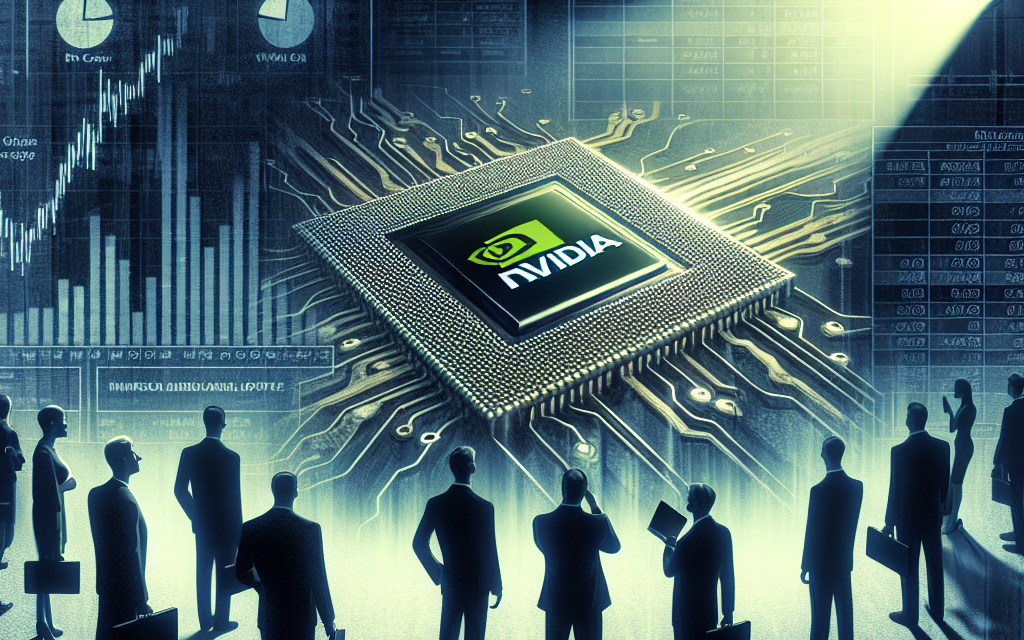“Wall Street Awaits: Nvidia Earnings and Fed Decisions Set the Stage for Market Moves”
Introduction
Wall Street is poised for a mixed opening as investors digest the latest earnings report from Nvidia and brace for potential shifts in Federal Reserve policy. Nvidia, a key player in the semiconductor industry, has released its quarterly results, which are being closely scrutinized for insights into the tech sector’s health and future growth prospects. Meanwhile, market participants are also focused on the Federal Reserve, anticipating any signals regarding interest rate adjustments or monetary policy changes that could impact economic conditions. This confluence of corporate earnings and central bank policy is creating a cautious yet watchful atmosphere among traders and analysts, as they navigate the complexities of the current financial landscape.
Nvidia Earnings Impact on Wall Street’s Opening Bell
As Wall Street prepares for the opening bell, investors are closely monitoring the mixed signals emanating from the financial landscape, particularly in light of Nvidia’s recent earnings report and the ongoing scrutiny of Federal Reserve policy. Nvidia, a leading player in the semiconductor industry, has long been a bellwether for technology stocks, and its financial performance often sets the tone for market sentiment. The company’s latest earnings report, which exceeded analysts’ expectations, has injected a dose of optimism into the market. However, this positive development is tempered by broader economic concerns, particularly those related to the Federal Reserve’s monetary policy.
Nvidia’s robust earnings report highlights the company’s continued dominance in the semiconductor sector, driven by strong demand for its graphics processing units (GPUs) and data center products. The company’s ability to navigate supply chain challenges and capitalize on the growing demand for artificial intelligence and gaming technologies has bolstered investor confidence. As a result, Nvidia’s stock is poised to make significant gains, potentially lifting the broader technology sector. This optimism, however, is not without its caveats, as investors remain wary of potential headwinds that could impact future growth.
While Nvidia’s performance provides a glimmer of hope, the broader market is grappling with uncertainty surrounding the Federal Reserve’s policy decisions. The central bank’s approach to interest rates and inflation continues to be a focal point for investors, as any indication of tightening monetary policy could have far-reaching implications for the stock market. Recent statements from Federal Reserve officials suggest a cautious approach, with an emphasis on data-driven decision-making. This has led to speculation about the timing and magnitude of potential interest rate hikes, creating a sense of unease among market participants.
In this context, the interplay between Nvidia’s earnings and Federal Reserve policy becomes particularly significant. On one hand, Nvidia’s strong performance underscores the resilience of the technology sector, which has been a key driver of market growth in recent years. On the other hand, the specter of rising interest rates looms large, as higher borrowing costs could dampen corporate investment and consumer spending, ultimately weighing on economic growth. This delicate balance between optimism and caution is reflected in the mixed opening that Wall Street is bracing for.
Moreover, the global economic environment adds another layer of complexity to the situation. Geopolitical tensions, supply chain disruptions, and fluctuating commodity prices continue to pose challenges for businesses and investors alike. These factors, combined with domestic policy considerations, contribute to a volatile market environment where sentiment can shift rapidly. As such, investors are advised to remain vigilant and adopt a diversified approach to mitigate potential risks.
In conclusion, as Wall Street gears up for the opening bell, the market is poised for a mixed start, influenced by Nvidia’s encouraging earnings and the ongoing scrutiny of Federal Reserve policy. While Nvidia’s performance offers a beacon of hope for the technology sector, broader economic concerns and policy uncertainties continue to cast a shadow over market sentiment. As investors navigate this complex landscape, the interplay between corporate earnings and monetary policy will remain a critical factor in shaping market dynamics in the coming weeks.
Federal Reserve Policy Decisions and Market Reactions
As Wall Street prepares for a mixed opening, investors are keenly focused on the dual influences of Nvidia’s earnings report and the Federal Reserve’s policy decisions. These two factors are poised to shape market sentiment and guide trading strategies in the coming days. Nvidia, a leading player in the semiconductor industry, recently released its quarterly earnings, which have been eagerly anticipated by market participants. The company’s performance is often seen as a bellwether for the technology sector, given its significant role in powering advancements in artificial intelligence and data processing. Consequently, Nvidia’s financial results and forward guidance are likely to have a ripple effect across tech stocks, influencing broader market trends.
Simultaneously, the Federal Reserve’s policy decisions remain a critical focal point for investors. The central bank’s approach to interest rates and monetary policy is under intense scrutiny, as market participants seek clarity on the Fed’s strategy to combat inflation while supporting economic growth. Recent statements from Federal Reserve officials have suggested a cautious approach, balancing the need to address inflationary pressures with the potential risks of stifling economic recovery. This delicate balancing act has left investors speculating about the timing and magnitude of future rate hikes, adding a layer of uncertainty to market dynamics.
In light of these developments, market reactions are expected to be mixed, with investors weighing the implications of Nvidia’s earnings against the backdrop of the Federal Reserve’s policy stance. On one hand, strong earnings from Nvidia could bolster confidence in the tech sector, potentially offsetting concerns about rising interest rates. On the other hand, any indication of a more aggressive monetary tightening by the Fed could dampen investor enthusiasm, particularly in interest rate-sensitive sectors such as technology and real estate.
Moreover, the interplay between corporate earnings and monetary policy highlights the broader challenges facing the market. As companies navigate supply chain disruptions and inflationary pressures, their ability to maintain profitability and growth becomes increasingly critical. At the same time, the Federal Reserve’s policy decisions will play a pivotal role in shaping the economic landscape, influencing borrowing costs, consumer spending, and business investment.
In this context, investors are likely to adopt a cautious approach, carefully analyzing earnings reports and economic indicators to gauge the market’s direction. The mixed opening on Wall Street reflects this cautious sentiment, as traders assess the potential impact of Nvidia’s performance and the Fed’s policy outlook on their portfolios. As the trading day unfolds, market participants will be closely monitoring any developments that could sway sentiment, including comments from Federal Reserve officials and additional corporate earnings releases.
Ultimately, the interplay between Nvidia’s earnings and the Federal Reserve’s policy decisions underscores the complexity of the current market environment. Investors must navigate a landscape characterized by both opportunities and risks, balancing the potential for growth with the challenges posed by inflation and monetary tightening. As Wall Street braces for a mixed opening, the focus remains on how these key factors will shape market dynamics in the days and weeks ahead, guiding investment strategies and influencing the broader economic outlook.
Tech Sector Volatility: Nvidia’s Role in Market Fluctuations
As Wall Street prepares for a mixed opening, the tech sector finds itself under intense scrutiny, with Nvidia at the center of attention. The semiconductor giant’s recent earnings report has sent ripples through the market, highlighting the volatility that characterizes the tech industry. Nvidia’s performance, often seen as a bellwether for the broader tech sector, has significant implications for investors and analysts alike. The company’s earnings exceeded expectations, driven by robust demand for its graphics processing units (GPUs) and data center products. However, despite these positive results, concerns about supply chain disruptions and geopolitical tensions continue to loom large, casting a shadow over the sector’s future prospects.
In the context of Nvidia’s earnings, it is essential to consider the broader economic environment, particularly the Federal Reserve’s monetary policy. The Fed’s stance on interest rates and inflation has been a focal point for investors, influencing market sentiment and investment strategies. As the central bank navigates the delicate balance between curbing inflation and supporting economic growth, its decisions have a direct impact on the tech sector, which is highly sensitive to changes in interest rates. Higher rates can increase borrowing costs for tech companies, potentially slowing down innovation and expansion efforts.
Moreover, the interplay between Nvidia’s performance and Fed policy highlights the interconnectedness of global markets. As Nvidia continues to expand its presence in international markets, it must contend with varying economic conditions and regulatory environments. This global reach underscores the importance of understanding how macroeconomic factors, such as currency fluctuations and trade policies, can affect the tech sector’s stability and growth. Consequently, investors must remain vigilant, keeping a close eye on both company-specific developments and broader economic indicators.
In addition to these macroeconomic considerations, the tech sector faces its own set of challenges, including rapid technological advancements and increasing competition. Nvidia, for instance, is constantly innovating to maintain its competitive edge, investing heavily in research and development to stay ahead of rivals. This relentless pursuit of innovation is crucial for sustaining growth, but it also introduces an element of uncertainty, as the success of new products and technologies is never guaranteed. Furthermore, the competitive landscape is continually evolving, with new entrants and established players alike vying for market share. This dynamic environment necessitates agility and adaptability, as companies must swiftly respond to changing consumer preferences and technological trends.
As Wall Street braces for a mixed opening, the tech sector’s volatility, exemplified by Nvidia’s role in market fluctuations, remains a key concern for investors. The interplay between company performance, macroeconomic factors, and competitive pressures creates a complex landscape that requires careful navigation. By staying informed and adopting a strategic approach, investors can better position themselves to capitalize on opportunities while mitigating risks. In this ever-changing environment, the ability to anticipate and respond to market shifts will be crucial for achieving long-term success. As such, Nvidia’s earnings and the Fed’s policy decisions serve as important reminders of the multifaceted nature of the tech sector and the broader financial markets.
Investor Sentiment: Balancing Nvidia’s Performance and Fed Announcements

Investor sentiment is currently navigating a complex landscape as Wall Street prepares for a mixed opening, influenced by Nvidia’s recent earnings report and the looming announcements from the Federal Reserve. The interplay between corporate performance and monetary policy is creating a nuanced environment for investors, who must weigh the implications of both factors on their portfolios.
Nvidia, a leading player in the semiconductor industry, recently released its quarterly earnings, which have been a focal point for market participants. The company’s performance is often seen as a bellwether for the tech sector, given its significant role in powering advancements in artificial intelligence, gaming, and data centers. Nvidia’s earnings exceeded market expectations, driven by robust demand for its cutting-edge graphics processing units (GPUs). This positive outcome has provided a degree of optimism among investors, suggesting that the tech sector may continue to experience growth despite broader economic uncertainties.
However, the enthusiasm generated by Nvidia’s strong performance is tempered by the anticipation of the Federal Reserve’s upcoming policy announcements. The central bank’s decisions on interest rates and monetary policy are critical factors that influence market dynamics. Investors are particularly attentive to any signals regarding the Fed’s approach to inflation and economic growth. Recent data indicating persistent inflationary pressures have fueled speculation that the Fed may adopt a more hawkish stance, potentially leading to interest rate hikes sooner than previously anticipated.
The juxtaposition of Nvidia’s earnings and the Fed’s policy outlook creates a delicate balancing act for investors. On one hand, the tech sector’s resilience, as exemplified by Nvidia, offers a promising avenue for growth-oriented investments. On the other hand, the prospect of rising interest rates could dampen market enthusiasm, as higher borrowing costs may weigh on corporate profits and consumer spending. This duality underscores the importance of a diversified investment strategy, as it allows investors to mitigate risks associated with sector-specific volatility and macroeconomic shifts.
Moreover, the broader market context cannot be ignored. Geopolitical tensions, supply chain disruptions, and ongoing concerns about the global economic recovery add layers of complexity to the investment landscape. These factors contribute to heightened market volatility, prompting investors to remain vigilant and adaptable in their decision-making processes. In such an environment, the ability to interpret and respond to a wide array of signals becomes paramount.
In conclusion, as Wall Street braces for a mixed opening, investor sentiment is being shaped by the interplay between Nvidia’s impressive earnings and the Federal Reserve’s policy trajectory. The tech sector’s potential for growth, highlighted by Nvidia’s performance, offers a glimmer of optimism. However, the uncertainty surrounding the Fed’s next moves serves as a reminder of the challenges that lie ahead. Investors must navigate this intricate landscape with a keen eye on both corporate fundamentals and macroeconomic indicators, ensuring that their strategies are well-positioned to capitalize on opportunities while managing potential risks. As the market continues to evolve, maintaining a balanced perspective will be essential for achieving long-term investment success.
Wall Street’s Mixed Signals: Navigating Uncertainty in Tech and Policy
As Wall Street prepares for the opening bell, investors find themselves navigating a landscape marked by mixed signals, with particular attention on Nvidia’s earnings report and the Federal Reserve’s policy decisions. The confluence of these factors has created an atmosphere of uncertainty, prompting market participants to tread cautiously. Nvidia, a leading player in the semiconductor industry, recently released its quarterly earnings, which have been a focal point for investors. The company’s performance is often seen as a bellwether for the broader technology sector, given its significant role in powering advancements in artificial intelligence, gaming, and data centers. Nvidia’s results exceeded analysts’ expectations, showcasing robust revenue growth driven by strong demand for its cutting-edge graphics processing units. However, despite these positive figures, concerns linger over potential supply chain disruptions and geopolitical tensions that could impact future performance.
Simultaneously, the Federal Reserve remains in the spotlight as it continues to navigate the delicate balance between fostering economic growth and curbing inflation. Recent statements from Fed officials have suggested a more hawkish stance, with the possibility of interest rate hikes on the horizon. This has led to heightened market volatility, as investors attempt to gauge the timing and magnitude of potential policy shifts. The Fed’s dual mandate of promoting maximum employment and maintaining price stability has become increasingly challenging in the current economic environment, characterized by persistent inflationary pressures and a labor market that is still recovering from the pandemic’s impact.
In this context, the interplay between Nvidia’s earnings and the Fed’s policy decisions underscores the broader challenges facing Wall Street. On one hand, the technology sector continues to be a driving force behind market gains, with companies like Nvidia leading the charge. On the other hand, the prospect of rising interest rates poses a threat to high-growth stocks, which are particularly sensitive to changes in borrowing costs. As a result, investors are left grappling with the question of how to position their portfolios in light of these competing dynamics.
Moreover, the global economic landscape adds another layer of complexity to the equation. Supply chain disruptions, exacerbated by geopolitical tensions and the lingering effects of the COVID-19 pandemic, have created bottlenecks that threaten to derail economic recovery. These challenges are particularly pronounced in the semiconductor industry, where shortages have hampered production and driven up costs. Consequently, companies like Nvidia are not only contending with strong demand but also navigating an increasingly complex supply chain environment.
In conclusion, Wall Street’s mixed signals reflect the broader uncertainty that characterizes the current market environment. As investors digest Nvidia’s earnings and anticipate the Federal Reserve’s next moves, they must weigh the potential risks and rewards associated with these developments. The interplay between technology sector performance and monetary policy will likely continue to shape market dynamics in the coming months. As such, a cautious approach, informed by a keen awareness of both macroeconomic trends and company-specific factors, will be essential for navigating this period of uncertainty. Ultimately, the ability to adapt to changing conditions and make informed investment decisions will be crucial for market participants seeking to thrive in this complex and evolving landscape.
The Intersection of Nvidia’s Earnings and Federal Reserve Strategies
As Wall Street prepares for the opening bell, investors find themselves navigating a complex landscape shaped by Nvidia’s recent earnings report and the Federal Reserve’s ongoing policy deliberations. These two pivotal factors are poised to influence market sentiment, creating a mixed outlook for the day ahead. Nvidia, a leading player in the semiconductor industry, has consistently been a bellwether for technological innovation and market trends. Its latest earnings report, therefore, holds significant weight in shaping investor expectations. The company’s performance not only reflects its own strategic initiatives but also serves as a barometer for the broader tech sector, which has been a major driver of market gains in recent years.
Nvidia’s earnings exceeded analysts’ expectations, showcasing robust growth in its data center and gaming divisions. This performance underscores the company’s ability to capitalize on the increasing demand for advanced computing solutions and graphics processing units. However, despite these positive results, Nvidia’s stock may face volatility due to broader market conditions and investor concerns about future growth prospects. The semiconductor industry, while thriving, is not immune to global supply chain disruptions and geopolitical tensions, which could impact Nvidia’s operations and profitability in the coming quarters.
Simultaneously, the Federal Reserve’s policy decisions remain a focal point for investors. The central bank’s approach to interest rates and monetary policy has far-reaching implications for financial markets. As inflationary pressures persist, the Fed faces the delicate task of balancing economic growth with price stability. Recent statements from Fed officials suggest a cautious approach, with a focus on data-driven decision-making. This has led to speculation about the timing and magnitude of potential interest rate adjustments, which in turn affects investor sentiment and market dynamics.
The intersection of Nvidia’s earnings and the Federal Reserve’s strategies creates a nuanced environment for market participants. On one hand, Nvidia’s strong performance could bolster confidence in the tech sector, encouraging investment and supporting stock prices. On the other hand, uncertainty surrounding Fed policy may temper enthusiasm, as investors weigh the potential impact of interest rate changes on economic growth and corporate profitability. This duality highlights the interconnectedness of corporate performance and macroeconomic policy, underscoring the importance of a comprehensive approach to market analysis.
Moreover, the broader economic context cannot be overlooked. Global economic conditions, including trade relations and fiscal policies, play a crucial role in shaping market trends. As such, investors must remain vigilant, considering both microeconomic factors, such as individual company performance, and macroeconomic indicators, such as inflation rates and employment data. This holistic perspective is essential for navigating the complexities of today’s financial landscape.
In conclusion, Wall Street’s mixed opening reflects the interplay between Nvidia’s earnings and the Federal Reserve’s policy considerations. While Nvidia’s strong results provide a positive signal for the tech sector, the overarching influence of Fed strategies introduces an element of uncertainty. Investors must carefully assess these factors, balancing optimism with caution as they make informed decisions in an ever-evolving market environment. As the day unfolds, market participants will continue to monitor developments closely, seeking to capitalize on opportunities while mitigating risks in this dynamic intersection of corporate performance and economic policy.
Market Predictions: Analyzing Wall Street’s Response to Key Economic Indicators
As Wall Street prepares for the opening bell, investors are keenly focused on a confluence of factors that could shape the market’s trajectory. The spotlight is firmly on Nvidia, a leading player in the semiconductor industry, as it prepares to release its earnings report. This event is anticipated to provide crucial insights into the tech sector’s health, particularly given Nvidia’s pivotal role in the burgeoning fields of artificial intelligence and data processing. Analysts are eager to dissect the company’s performance metrics, looking for signs of sustained growth or potential headwinds that could influence investor sentiment.
Simultaneously, the Federal Reserve’s policy decisions remain a critical focal point for market participants. Recent statements from Fed officials have suggested a cautious approach to interest rate adjustments, reflecting ongoing concerns about inflationary pressures and economic stability. The central bank’s policy stance is a key determinant of market dynamics, as it influences borrowing costs, consumer spending, and overall economic activity. Investors are therefore closely monitoring any signals from the Fed that might indicate a shift in monetary policy, which could have far-reaching implications for asset valuations and market volatility.
In this context, the interplay between corporate earnings and monetary policy is particularly significant. Nvidia’s earnings report is expected to serve as a bellwether for the tech sector, with potential ripple effects across related industries. A strong performance could bolster confidence in tech stocks, driving broader market gains. Conversely, any indication of slowing growth or margin pressures could exacerbate existing concerns about the sector’s resilience in the face of macroeconomic challenges.
Meanwhile, the Fed’s policy deliberations are likely to influence investor expectations regarding future interest rate movements. A more hawkish stance could prompt a reassessment of risk assets, as higher rates typically lead to increased borrowing costs and reduced liquidity. On the other hand, a dovish approach might provide a temporary reprieve for markets, supporting risk appetite and encouraging investment in growth-oriented sectors.
As these developments unfold, market participants are also attuned to other economic indicators that could impact sentiment. Recent data releases on employment, consumer spending, and manufacturing activity have painted a mixed picture of the U.S. economy, adding another layer of complexity to the market outlook. While some indicators suggest robust economic momentum, others point to potential vulnerabilities that could weigh on growth prospects.
In navigating this intricate landscape, investors are employing a range of strategies to manage risk and capitalize on opportunities. Diversification remains a key tenet, as it allows market participants to mitigate exposure to sector-specific risks while capturing potential upside across different asset classes. Additionally, many are adopting a cautious approach, maintaining a balanced portfolio that includes both defensive and growth-oriented investments.
Ultimately, Wall Street’s response to these key economic indicators will hinge on the interplay between corporate performance and monetary policy. As Nvidia’s earnings and the Fed’s policy stance come into sharper focus, investors will be tasked with deciphering the implications for market dynamics and positioning themselves accordingly. In this ever-evolving environment, the ability to adapt to changing conditions and anticipate future trends will be paramount for those seeking to navigate the complexities of the financial markets.
Q&A
1. **What is the current market sentiment on Wall Street?**
Wall Street is experiencing a mixed sentiment as investors brace for Nvidia’s earnings report and await signals from the Federal Reserve regarding future monetary policy.
2. **Why are Nvidia’s earnings significant?**
Nvidia’s earnings are significant because the company is a major player in the tech sector, and its performance can influence market trends and investor confidence, especially in the semiconductor industry.
3. **What are investors expecting from the Federal Reserve?**
Investors are looking for clues on the Federal Reserve’s future policy direction, particularly regarding interest rates and any potential changes in monetary policy that could impact economic growth and inflation.
4. **How might Nvidia’s earnings impact the stock market?**
Strong earnings from Nvidia could boost tech stocks and overall market sentiment, while disappointing results might lead to a sell-off in tech shares and increased market volatility.
5. **What other factors are influencing Wall Street’s opening?**
Besides Nvidia’s earnings and Fed policy, other factors include global economic data, geopolitical developments, and corporate earnings from other major companies.
6. **How are tech stocks performing ahead of Nvidia’s earnings?**
Tech stocks are showing mixed performance as investors remain cautious, balancing optimism about potential strong earnings with concerns over high valuations and broader economic uncertainties.
7. **What is the potential impact of Fed policy on the markets?**
Any indication of a shift in Fed policy, such as changes in interest rates or asset purchases, could significantly impact market liquidity, borrowing costs, and investor risk appetite, leading to potential market volatility.
Conclusion
Wall Street is poised for a mixed opening as investors digest Nvidia’s earnings report and anticipate further insights into Federal Reserve policy. Nvidia’s performance, a key indicator for the tech sector, has shown robust growth, yet market reactions remain cautious due to broader economic uncertainties. Meanwhile, the Federal Reserve’s policy decisions continue to be a focal point, with investors closely monitoring any signals regarding interest rate adjustments. This combination of corporate earnings and macroeconomic policy is creating a complex landscape for market participants, highlighting the ongoing volatility and uncertainty in the financial markets.





